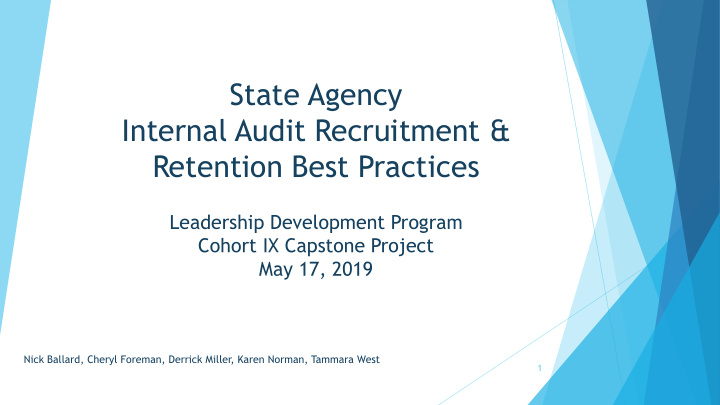



State Agency Internal Audit Recruitment & Retention Best Practices Leadership Development Program Cohort IX Capstone Project May 17, 2019 Nick Ballard, Cheryl Foreman, Derrick Miller, Karen Norman, Tammara West 1
Presentation Overview 1. Project Objective and Methodology 2. State Agency Audit Environment 3. Recruitment Challenges and Best Practices 4. Retention Challenges and Best Practices 2
Project Objective and Methodology 3
Project Objective To develop a long-term strategy to recruit and retain internal auditing talent within state government 4
Methodology Conduct interviews with State Chief Audit Executives, Human Resources and Private Sector Recruitment staff Survey accounting students from the University of Texas at Austin and St. Edwards University Research challenges and best practices for recruitment and retention 5
State Agency Audit Environment 6
State Agency Audit Environment Job Classifications of Auditors 10% 15% 21% 25% 29% Auditor I-II Auditor III Auditor IV Auditor V Auditor VI 7
State Agency Audit Environment How Long Auditors have Worked for the State 200 180 160 140 120 100 80 60 40 20 0 >2 Yrs 2-5 Yrs 5-10 10-15 15-20 20-25 25+ Yrs 80% have 10 years or less tenure with the State 60% have 5 years or less 8
State Agency Audit Environment Workforce with <5 yrs 9
Recruitment Challenges and Best Practices 10
Recruitment Challenges Chief Audit Executive Feedback Attracting qualified candidates Providing competitive compensation Ensuring swift hiring process with succinct job descriptions and smooth onboarding experience 11
Recruitment Challenges Student Feedback Gain knowledge of career opportunities through on-campus recruiting, networking, and internships Committed to employer by December Focus on external audit and consulting 12
Recruitment Best Practices 1. Develop Marketing Strategy Promote the internal audit career (impact, growth, benefits) Tailor your message (mission, team, and value proposition) Provide candid job information Monitor job evaluation sites 13
Recruitment Best Practices 2. Identify target characteristics Ability to synthesize Industry knowledge Curiosity Self-Starter Backbone Conscientiousness is crucial 14
Recruitment Best Practices 3. Identify Talent Sources Referrals from high-quality staff and professional network Social media Non-traditional audit candidates Professional organizations University Students 15
Recruitment Best Practices 4. Establish Recruitment Process Timely offers Ensure regular contact during recruitment Ensure succinct job descriptions that are not overly restrictive Ensure employer website grabs candidate’s attention and is easy to navigate 16
Retention Challenges and Best Practices 17
Retention Challenges Chief Audit Executive Feedback Providing competitive compensation Opportunities for promotion not available State government pace not fast enough 18
Retention Challenges Causes of Turnover Exit interviews may not tell the full story (Hint: Salary is not always the answer) Turnover predictors include poor Organizational commitment and job satisfaction Relationship with immediate supervisor Role clarity Job design Workgroup cohesion 19
Retention Challenges Executives think employees want Physically pleasing environment and workplace amenities Education opportunities Rewards and incentives Employees say they want Ability to disconnect work-life balance Transparency Sense of purpose Ability to develop meaningful relationships 20
Retention Best Practices 1. Recruit the right people 2. Implement successful onboarding, help new employees a. Learn what makes the organization unique b. Learn how their jobs help fulfill the mission 3. Listen to new employees early a. Meet to discuss background and how it fits with current job b. Draft sample career path based on their future goals 21
Retention Best Practices 4. Engage through career development a. Job design – variety, autonomy b. Performance management – challenging goals, positive feedback c. Conversations – regular, one-on-one, high feedback d. Manager Training - how to lead and develop effective relationships with team e. Audit Plan – include value-add and varying projects 22
Retention Best Practices 5. Engage through supportive environment a. Communication - value of audit, culture, organizational changes, clear expectations b. Team – team building activities, foster collaboration, celebrate milestones c. Work-Life – support healthy balance, time to disconnect d. Stay Interviews – what would you improve? e. Assess Strategy – at least once per year 23
Key Takeaways 24
Key Takeaways Recruitment Best Practices 1. Develop Marketing Strategy 2. Identify target characteristics 3. Identify Talent Sources 4. Establish Recruitment Process Retention Best Practices 1. Recruit the right people 2. Implement successful onboarding 3. Listen to new employees early 4. Engage through career development 5. Engage through supportive environment 25
Additional Innovative Ideas 1. Agreed upon training 6. New employee surveys program sponsored by SAIAF 7. Internal Auditor standalone 2. Creative use of other classification series classifications 8. Review your process 3. Guest auditor programs 9. Shift your hiring perspective 4. Intern-to-entry-level 10. State IA - “Me” or “We” programs 5. Geographic adjustments for starting salaries 26
Thank you for allowing us the opportunity to serve the SAIAF community! Nick Ballard, Cheryl Foreman, Derrick Miller, Karen Norman, Tammara West 27
Recommend
More recommend